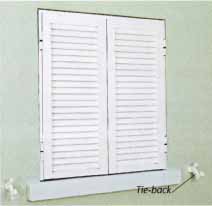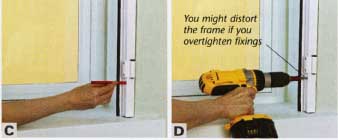Window shutters can be installed internally or externally and are available in a variety of traditional and modern styles. Most shutters are decorative, but some provide increased security and shutters. Internal shutters can be used instead of curtains -- they take up less room and don’t become damp in steamy bathrooms privacy. Protect windows from weathering with external and kitchens. Shutters are easily cleaned, and allergy sufferers often find them preferable to curtains.
SECURITY SHUTTERS
Exterior roll-down security shutters are available. These are often motorized and can be easily operated from inside the home. The modern, unobtrusive designs also offer excellent heat and sound insulation. If you wish to fit security shutters, seek advice from a manufacturer. They will usually measure the window for you, then make and install them to your exact specifications.
CHOOSING SHUTTERS
Once you have decided whether you want internal or external shutters, choose what style you prefer. Solid or louver panels are most common -- some louver designs are adjustable so you can control the amount of light that you let in. Manufacturers may offer a range of other options such as tongue-and-groove, solid panels with designs cut out of them, or shutters that only cover the lower half of the window. Shutters can be made of traditional wood, as well as aluminum, vinyl, and a range of other materials. Wooden shutters require more regular maintenance than other materials such as aluminum and vinyl. Whatever material you choose, it's worth buying pre-finished shutters -- louvered shutters are very time-consuming to paint. Shutters are usually supplied with catches to hold them closed and tie-backs to secure them in an open position.
MEASURING
Shutters are usually custom-built for your windows or recesses. Before placing an order for shutters, take note of any mechanisms and installation procedures and make sure they are compatible with your window. If you are installing the shutters into a window recess, make sure there is enough room to fit them without blocking out light. You will need to measure carefully. Most companies will provide specific guidelines on how and where to take the crucial measurements. When you are measuring a window recess, make sure that you take at least three measurements for the width and height of the opening. Use the smallest of the three, because walls are rarely dead straight. This is a technique similar to that used for measuring for a new window frame.

Adjustable louver shutters: These are an excellent choice if shutters
are being used instead of curtains. You can vary the amount of light
(and air) you let into the room by swiveling the louvers, and angle
them to increase privacy.
MOUNTING OPTIONS
When you have decided on the style of your shutters, there are two main options for installing them. Frame-mounting is the most straightforward technique. The shutters are built into a two-, three-, or four-sided frame, which is then attached around or into the window recess. Alternatively, the shutter hinges can be attached directly to the existing window frame or jamb. This is known as hinge-mounting. With either option, you need to decide whether the shutters are going to be mounted within the window recess or around the opening. Internal shutters are often installed in the recess. External shutters are usually mounted so they are flush with, or just proud of the wall when they are closed.

Interior shutters: You can maximize the feeling of
space and light that shutters give an interior by installing them inside
the window recess. The frame of the window will need an adequate depth
to accommodate the shutters and their fastenings without cutting out
light. Large shutters are available that fold like an accordion to rest
neatly against the wall surface.

Exterior shutters: These can be mounted to open out
flat against the wall on either side of the window. This requires free
wall space, and room for them to swing into position. You can use offset
hinges to allow the shutters to shut into the mouth of the window recess
when closed (shown above). Alternatively, you can mount the shutters
on the wall around the window.
TOOLS AND MATERIALS NEEDED
- Installing interior shutters: Level, wooden off-cuts, molding strip, filler
- Installing exterior shutters: Level, wooden off-cuts
INSTALLING INTERIOR SHUTTERS
Here, shutters are being frame-mounted into a window recess. The shutter frame is fixed to the window frame so the shutters take up as little space as possible when they are open or closed. Most types of shutters are installed in a similar way, but you should precisely follow the assembly and installation guidelines specific to those you purchase.

A. Construct the frame using the fasteners provided. Here, dowels
are used at each corner to hold the frame together. B. Position the
shutter frame in the recess and make sure it slides neatly into place
against the window frame.

C. Use a level to check that the frame is precisely square. Wedge
wooden off-cuts between the frame and recess if any packing is required.
D. Drill pilot holes, then screw through the shutter frame and into
the window frame at the top, bottom, and center of each member.


E. Position the shutters. Align the two sections of
the loose-pin hinges. Follow specific instructions if your shutters
use different hinges. F. Insert the pins into the
hinges. Check that the shutters open and close smoothly -- try adjusting
the frame packing if they don’t. G. Clip or stick lengths of molding
over the frame to cover the fasteners. If there are gaps between the
frame and the wall, you can fit more lengths of molding to hide them.
Alternatively, mask the shutter frame with low-tack tape while you
fill the gaps, then paint the filled areas to match the wall.
INSTALLING EXTERIOR SHUTTERS
Exterior shutters are often mounted on a three-sided frame so that there is no frame member along the window sill. This type of design is neater, and allows rainwater to run off the sill easily to prevent problems with rot or mildew. Because exterior shutters are exposed to the elements, make sure you choose hardwearing or factory-coated materials.

A. Construct the frame as specified, unless it's supplied ready-made.
Position the frame at the front of the recess. Check the fit. B. Use
a level to check that the frame is square. If packing is required,
get help holding the frame while you make any adjustments.

C. Mark the predrilled hole positions on the wall. If holes aren't predrilled, then attach each member at the top, bottom, and center.
D. Remove the frame and drill the pilot holes using a suitable bit.
Plug the holes if necessary, then reposition the frame and attach it
in place.


E. Lower the hinge sections on the shutter onto the hinge sections
secured to the frame. The shutter should easily slide into place when
the hinges are correctly aligned. Check that the shutters open and close smoothly. F. Position the tie-backs. Open the shutters to get
the right level, then make sure you will be able to reach them from
inside. Screw into place. G. Check that the tie-backs operate smoothly and make any adjustments as required.